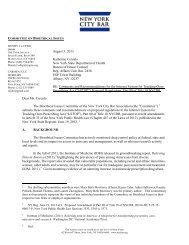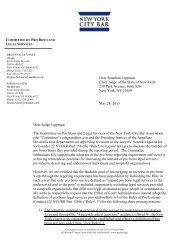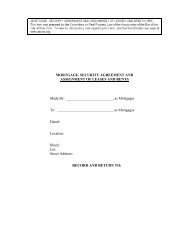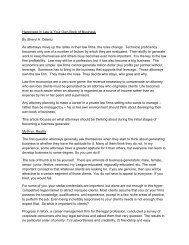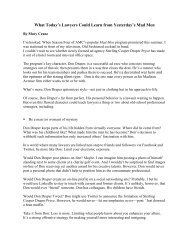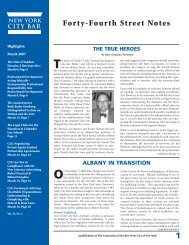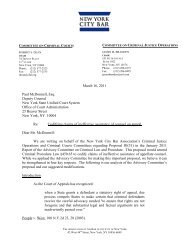Letter to the Federal Insurance Office (FIO) - New York City Bar ...
Letter to the Federal Insurance Office (FIO) - New York City Bar ...
Letter to the Federal Insurance Office (FIO) - New York City Bar ...
You also want an ePaper? Increase the reach of your titles
YUMPU automatically turns print PDFs into web optimized ePapers that Google loves.
that have enough capital <strong>to</strong> withstand major loss events or <strong>to</strong> finance <strong>the</strong> strain on capitalfrom writing new business could exist.Risk management. First, and most importantly, reinsurance lays off risk, <strong>the</strong>rebytransferring it <strong>to</strong> entities better able and more willing <strong>to</strong> bear it. This allows a directinsurer <strong>to</strong> calibrate its risk <strong>to</strong>lerance levels with more precision. For example, an insurermay wish <strong>to</strong> cap its losses from a particular event or exposure. In <strong>the</strong> property/casualtyarena, <strong>the</strong> covered losses could be all losses from a single catastrophic event or fromsingle peril (e.g., winds<strong>to</strong>rm or earthquake) or in a single geographic region. In <strong>the</strong> lifeinsurance arena, reinsurance may serve <strong>to</strong> cap morbidity and mortality risk, persistencyrisk (<strong>the</strong> risk associated with policyholders' allowing policies <strong>to</strong> lapse or surrendering<strong>the</strong>ir coverage) or investment risk (credit, interest rate and reinvestment). In <strong>the</strong>seexamples, reinsurance allows <strong>the</strong>se risks <strong>to</strong> be dispersed among multiple reinsurers,which may agree <strong>to</strong> be exposed <strong>to</strong> ei<strong>the</strong>r "vertical" (losses above or below certainattachments points) or "horizontal" (pro rata exposure <strong>to</strong> a single tranche of losses) slicesof <strong>the</strong> same risk.The ability <strong>to</strong> cap or reduce risk exposure is critical <strong>to</strong> insurers, because o<strong>the</strong>rwise <strong>the</strong>ywould have <strong>to</strong> hold more capital (for regula<strong>to</strong>ry, rating and risk-management reasons) asa cushion against greater-than-expected losses or losses that are expected but with lessfrequency. 4 In addition, in <strong>the</strong> absence of reinsurance, insurers might face undiversifiedrisks <strong>to</strong> specific geographic regions or perils. Reduced balance-sheet and earningsvolatility resulting from reinsurance can moderate <strong>the</strong>se effects and enable insurers <strong>to</strong>attract capital from inves<strong>to</strong>rs <strong>to</strong> support <strong>the</strong>ir underwriting activity.Increases underwriting capacity. Reinsurance increases ceding insurers' underwritingcapacity by reducing net premiums and liabilities. Most states have laws that limit aninsurer's net exposure <strong>to</strong> any single risk <strong>to</strong> 10 percent of its policyholder surplus.Regula<strong>to</strong>rs, rating agencies and market analysts closely watch individual insurers'premium volumes and <strong>to</strong>tal liabilities relative <strong>to</strong> <strong>the</strong>ir capital base <strong>to</strong> determine whe<strong>the</strong>r<strong>the</strong>y are operating with <strong>to</strong>o much leverage. Reinsurance, ceteris paribus, serves <strong>to</strong> reducean insurer's net liabilities and net written premiums for purposes of calculating applicableratios and net exposure. The principle underlying this accounting treatment is that <strong>the</strong>risk has been laid off <strong>to</strong> <strong>the</strong> reinsurer, as discussed above.For example, an insurer that cedes 50% of its premiums and losses <strong>to</strong> a reinsurer willneed <strong>to</strong> hold only half of <strong>the</strong> additional capital that it o<strong>the</strong>rwise would need <strong>to</strong> hold foreach additional policy (though <strong>the</strong> insurer may have a capital charge for cededreinsurance), and <strong>the</strong> risk will be cut by half for purposes of applying <strong>the</strong> 10% single riskrule. In <strong>the</strong> life insurance arena, "ceding commissions" paid by reinsurers helpcompensate <strong>the</strong> ceding insurer for expenses borne by it in acquiring <strong>the</strong> risks in <strong>the</strong> first4CPAM: 4886365.12Insurers are required <strong>to</strong> hold capital as a cushion in case losses under <strong>the</strong>ir policies exceed <strong>the</strong>assets <strong>the</strong>y set aside as reserves. <strong>Insurance</strong> regula<strong>to</strong>rs and rating agencies moni<strong>to</strong>r capital levelsand form judgments concerning whe<strong>the</strong>r insurers are operating with a capital cushion that isadequate in relation <strong>to</strong> <strong>the</strong> volume of <strong>the</strong>ir insurance business or <strong>the</strong> size of <strong>the</strong>ir liabilities. Theydo this by calculating premium-<strong>to</strong>-surplus and liabilities-<strong>to</strong>-surplus ratios and risk-based capitaland o<strong>the</strong>r similar ratios that <strong>the</strong>y use <strong>to</strong> moni<strong>to</strong>r insurers' activities. Commercial counterpartiessuch as lenders and o<strong>the</strong>r inves<strong>to</strong>rs will also be alert <strong>to</strong> insurers' capital adequacy.3



